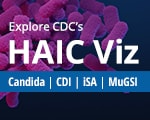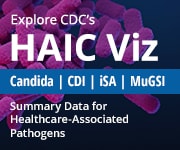HAICViz
HAICViz allows you to analyze and visualize data for HAIC surveillance, including Candida bloodstream infections, Clostridioides difficile infections, Staphylococcus aureus infections, and case data collected through the Multi-site Gram-negative Surveillance Initiative. Depending on the pathogen, you can look at certain types of data, including:
- Number of case counts and deaths
- Case and death rates
- Strain types
- Syndromes
- Antimicrobial resistance
Data Collection
The HAIC was established in 2009 and encompasses several ongoing surveillance activities, some of which pre-date the formation of the HAIC program. More information about the individual surveillance activities that make up the HAIC can be found by clicking on the links below:
- Candida bloodstream infections (candidemia)
- Clostridioides difficile infections
- Invasive Staphylococcus aureus infections
- Multi-site Gram-negative Surveillance Initiative (including surveillance for carbapenem-resistant Enterobacteriaceae, carbapenem-resistant Acinetobacter baumannii)
Interpretation
- Data presented in HAICViz may differ from other HAIC publications since different datasets or methods may be used.
- Small numbers for some topics or filters may make year to year changes difficult to interpret.
- Since each infection may have unique characteristics, the information available to display differs by individual organism.
More Details
- Methodology
Find details about surveillance population, case determination, surveillance evaluation, and more on our program-specific pages: - Reports and Findings
You can access reports or lists of publications using HAIC data on our program-specific pages:- Candida bloodstream infections (candidemia): data report
- Clostridioides difficile infections: annual reports; publications
- Invasive Staphylococcus aureus infections: annual reports; publications
- Multi-site Gram-negative Surveillance Initiative (including surveillance for carbapenem-resistant Enterobacteriaceae and carbapenem-resistant Acinetobacter baumannii): annual reports; publications
1. Select an organism or group of organisms of interest
Data are available for Candida species, Clostridioides difficile, Staphylococcus aureus, carbapenem-resistant Enterobacteriaceae (limited to Escherichia coli, Enterobacter cloacae, Klebsiella aerogenes, Klebsiella pneumoniae and Klebsiella oxytoca), and carbapenem-resistant Acinetobacter baumannii complex.
2. Select a topic of interest
Topics vary by organism. Topics may include case counts and rates, death rates, type of infection, epidemiologic class, strain type and antimicrobial resistance information. Some topics can be broken down further, such as by age, race, or sex. Epidemiological class refers to where the infection started—if onset was in a healthcare facility or in a community setting—and whether the infection was associated with a healthcare exposure or not. Epidemiological classes and definitions vary by organism.
3. Select the years of interest
Available years of data vary by organism. You can either look at data for several years in a single graph or look at data from individual years.
4. Select different ways to view the data
The data can be displayed in a graph or a table. Hovering your mouse over or selecting a data point or bar in the graph will display detailed information. Some graphs allow you to hide or show data from the legend for detailed analysis.

Copy the code for this HAICViz button (150×120):

Copy the code for this HAICViz button (180×150):